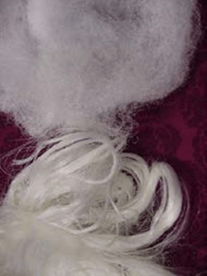A few years ago, the slogan for polyester fibers might have been, “We’re number three. We try really hard.” After being a distant third to nylon and olefin, polyester’s market share has grown in the last few years. Nylon is still #1 in sales by dollars but polyester is now #1 in actual volume of the fiber sold. If we look just at residential carpets, polyester has a big lead. Nylon’s large lead in carpet installed over the years has been eroded and there is now as much polyester on the floors we are cleaning. These figures are based on PET (polyethylene terephthalate) fiber and do not include close relative PTT or Triexta fiber.

Traditional benefits of polyester fibers include:
- A soft “hand” or feel when used in thick cut-pile
- carpet
- Can be dyed to a wide variety of bright, clear colors
- Resistance to water-based stains and soil
- Economical cost
As with other synthetics carpet fibers, polyester is relatively resistant to abrasion, resistant to damage from most chemicals likely to come in contact with a carpet, and resistant to mold.
In addition to carpet face yarns, you’ll find polyester used in moderately-priced upholstery including microfiber.
Polyester History
Polyester was among the earliest synthetic fibers created. In 1930 Julian Hill working in the DuPont labs under the direction of Wallace Carothers (who would later develop nylon) produced polyester 3-16. This was a significant scientific breakthrough but the result was not suitable as the synthetic silk that DuPont was looking for. The PET (polyethylene terephthalate) that is today’s most popular variety of polyester was first made in DuPont labs in 1934. Again this polymer did not suit the intended purpose of substituting for silk, so DuPont moved on and did nothing with this fiber. PET polyester was re-invented some years later in England. In 1953 DuPont began manufacturing PET under a license agreement. They called their fiber Dacron, one of many trade names that polyester has been known as over the years.

Besides carpet, upholstery, and drapery fibers, polyester is used in a variety of everyday products including plastic soda pop bottles. Mohawk uses millions of recycled pop bottles daily in the manufacture of carpets. Great for the environment, a feature often promoted by sellers of polyester carpets.
Improvements have been made to polyester fibers in recent years. If you drink bottled water, you may have noticed the material the bottles are made from has gotten thinner and the plastic does not turn white as easily where dented. This is due to tougher, more resilient polyester.
A decade ago, most polyester carpets were made from staple fibers. This allowed for a better blending of different dye batches and more even color. Staple fibers also had a softer “hand” or fell. Today almost all polyester carpet is bulked continuous filament (BCF).
Cleaning Polyester Fibers
Polyester can be cleaned with hot water extraction but encapsulation is also effective. Dry soils and water-based soil released rather easily. Polyester does have an affinity or attraction for oily soils so a prespray that includes solvents or a solvent booster is a good idea. Heat and dwell time are also important to help loosen oxidized oils. More frequent cleaning and use of a prespray that works well on oils and grease are suggested. Prespray with a pH of 10.0 or fewer works but higher pH products are successful because the alkalinity helps cut through oily soil. Use the rinse of your choice as neutralizing the alkalinity is not as necessary as with nylon.
Cleaning temps that are safe for other synthetics are suitable for polyester. So, is there any ‘bogeyman’ to watch out for? Definitely, yes. Despite engineered performance improvements in recent years, polyester is still not as resilient as nylon and is also prone to crimp loss. Over time, traffic stretches the fibers removing the crimp that provided bulk and loft. The stretched-out fiber now looks flat and lifeless. Colors lose their boldness. Cleaning cannot correct this. Be sure to adjust customer expectations accordingly.
Microfiber
One of the reasons for polyester’s continuing popularity is microfiber. “What is microfiber?” you ask. Microfibers are composed of very low denier material consisting of polyester or a blend of polyester and polyamide (nylon). By way of comparison, human hair has a thickness equal to about 20 deniers. Silk fibers range from 8 down to 1 or 2 deniers. Microfibers have a denier of less than 1. Some microfibers are as small as .01 denier, hundreds of times smaller than a strand of hair.
Melt spinning techniques won’t produce a fiber that thin. So after spinning a thin fiber, it is split into 16 or more fibers. These ultra-thin fibers are made into cleaning cloths, bonnets, and popular microfiber upholstery. Many of the new ultrasoft carpets such as Mohawk Smartstrand Silk and Shaw Caress lines include polyester microfiber.
by Scott Warrington
